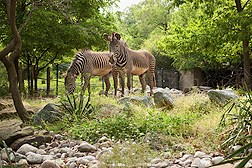|
|
Trapping Stable Flies at Zoos
Humans aren’t the only ones visiting zoos nowadays. The stable fly, typically a pest of farm animals, also pesters tigers, foxes, and other exotic species in zoos. A biting insect that feeds on blood, the stable fly, Stomoxys calcitrans, can create open lesions on the animals.
Scientists at the Smithsonian’s National Zoological Park in Washington, D.C., and the Agricultural Research Service’s Center for Medical, Agricultural, and Veterinary Entomology (CMAVE) in Gainesville, Florida, are testing the effectiveness of traps in capturing and killing flies at zoos.
“The more adult flies trapped, the fewer are available to bite and feed on exhibit animals,” says Smithsonian entomologist Gregory Ose. “Pesticides are effective, but it is not always possible to use them on zoo animals.”
Some zoo animals do not tolerate pesticides applied directly to their bodies, he says. In addition, animals often quickly remove treatments by rubbing, rolling, or licking them off.
Stable flies are not reproducing at the zoos, says entomologist Jerome Hogsette, who works in CMAVE’s Mosquito and Fly Research Unit. These pests—which also bite humans and dogs—prefer a habitat of decaying fibrous plant materials, such as hay, silage, or grass clippings.
“The National Zoo in Washington, D.C., one of the places where we set traps, is very clean and does not have any accumulation of waste that these flies might utilize,” Hogsette says. “We canvassed the whole zoo and never found signs of stable fly development.”
The nearest site of agricultural production is about 60 miles west of the National Zoo, which leads researchers to believe that flies are arriving with prevailing winds. “Stable flies can move with weather systems, traveling much farther than they normally do,” Hogsette says. “We also believe that similar weather-related movements are bringing stable flies to zoos in Chicago and Virginia.”
|
|
Ose and Hogsette evaluated the effectiveness of blue-black cloth targets covered with clear sticky wraps to capture stable flies. Scientists think that the blue-black color contrast may mimic natural forest edges where stable flies alight to rest and digest their food.
Target traps were compared with Alsynite fiberglass adhesive traps, the standard trap used for years to capture and monitor stable fly populations. Traps were placed at 10 sites for 15 weeks at a zoological park in Reston, Virginia. The modified traps captured fewer stable flies than the Alsynite traps. Only 20 percent of the approximately 12,550 stable flies captured were trapped on the modified traps.
Results suggest that modifying the blue-black cloth target surface reduces its attractive qualities, rendering it ineffective, Ose says. However, the research provided data on stable fly distribution and seasonality, which could make it easier to manage this pest at zoos by predicting the best times to set out traps.
Scientists are continuing their research to help monitor and manage stable flies at zoos. They have gathered 3 years of population data from the National Zoo and are testing new traps that have just come on the market.—By Sandra Avant, Agricultural Research Service Information Staff.
This research is part of ARS National Program #104, Veterinary, Medical, and Urban Entomology.
"Trapping Stable Flies at Zoos" was published in the February 2015 issue of Agricultural Research magazine.









